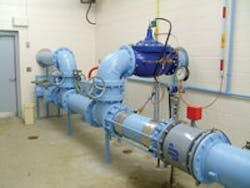About the author: Jim Klauer is regional sales manager for Danfoss VLT Drives. Klauer can be reached at salesinformation@ danfoss.com or 800.621.8806.
Like many areas across the U.S. and around the world, the community of Loves Park, located in northern Illinois, is growing. With growth comes the challenge of expanding services in a manner that not only is workable, but also is cost-effective in both the near and long term.
Growing Demands
As new subdivisions and businesses were added to the Loves Park water distribution system, the city was faced with the challenge of how to best serve growing demands. The community already utlized five water wells and three 500,000-gal water towers to maintain adequate pressure; however, growth along its eastern edge meant that more demand was being placed on the system. Without the introduction of additional system capacity, the increased flow eventually would cause a decrease in pressure.
Added Power
The city’s water department decided to install a new well to provide this additional capacity. The new well is 1,400 ft deep and is fitted with a submersible pump located roughly 800 ft below the surface. Jerry Janzen of Instrument Control Systems, Plymouth, Minn., designed the system required to efficiently operate the pump motor.
“In order to maximize the control and energy efficiency of the well and pumping station, we used a 350-hp Danfoss VLT Aqua variable- frequency drive [VFD],” Janzen said.
The VFD is connected to the city’s SCADA system, allowing it to run the pump motor at whatever speed necessary to maintain the appropriate system pressure.
By matching the actual demands of the water distribution system and running the pump at less than full speed, the VFD is able to provide significant energy savings and reduce water losses. Furthermore, it gives the Loves Park water department the abil- ity to plan for future expansion. As new developments are built and flow continues to increase, the drive will automatically run the pump motor at the necessary speed needed to meet the increased demands and maintain the pressure setpoint.
Cost Benefits
One of the primary advantages of using VFDs is the capability to pro- vide constant pressure at variable flow conditions. The drive at Loves Park’s Well Number 6 provides between 200 and 1,600 gal per minute at a pressure of 70 psi. In many ways, this is a preferable alternative to using water towers, which are more costly to install and maintain.
It was determined that using a medium-voltage motor would further reduce overall costs due to the significantly smaller diameter motor cables that it would require; as the voltage increases, the amount of current required to perform the same amount of work decreases.
The 460-VAC output of the VLT Aqua drive is wired to a step-up transformer, which brings the voltage to 2,400 VAC. The output of the transformer then is fed through a sine wave filter to ensure that the waveform is exceptionally uniform, prolonging the life of the motor. At 460 VAC, the motor would have required very thick cables to carry the current needed to operate the pump; however, at 2,400 VAC, the current required is much lower, meaning a smaller wire gauge could be used. With 800 ft of cable, this resulted in a significant savings.
The use of VFDs also minimizes equipment stress. By significantly reducing the number of starts required of the well pump, the drive maximizes the pump motor’s longevity. Controlling the acceleration and deceleration when starting and stopping further lowers stress to the motor, and also reduces water hammer in the pipe system.
The drive also will allow the city to perform maintenance on its water towers without impact to water distribution.
“Right now, this pumping station is filling the gap,” said Craig McDonald, department supervisor for Loves Park Water. “But it will also allow us to bypass a tower in order to maintain it while still providing water to the people who rely on it.”
The VFD provides the system with the flexibility to meet the needs of the community, both today and in the future. 
Download: Here
